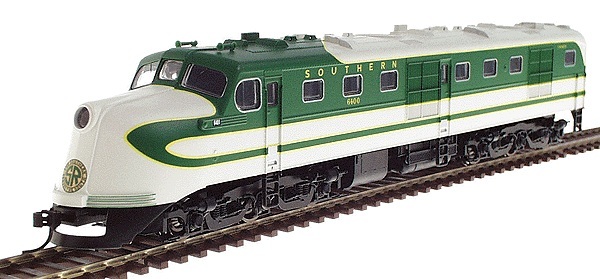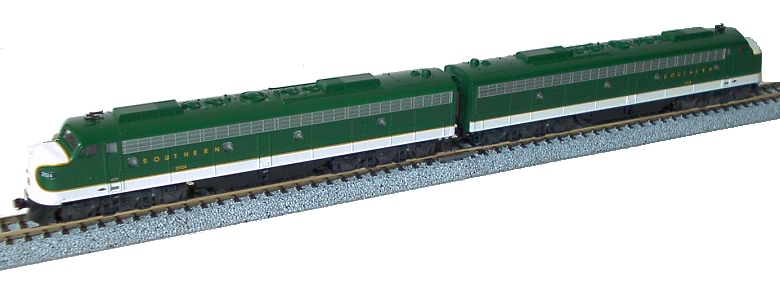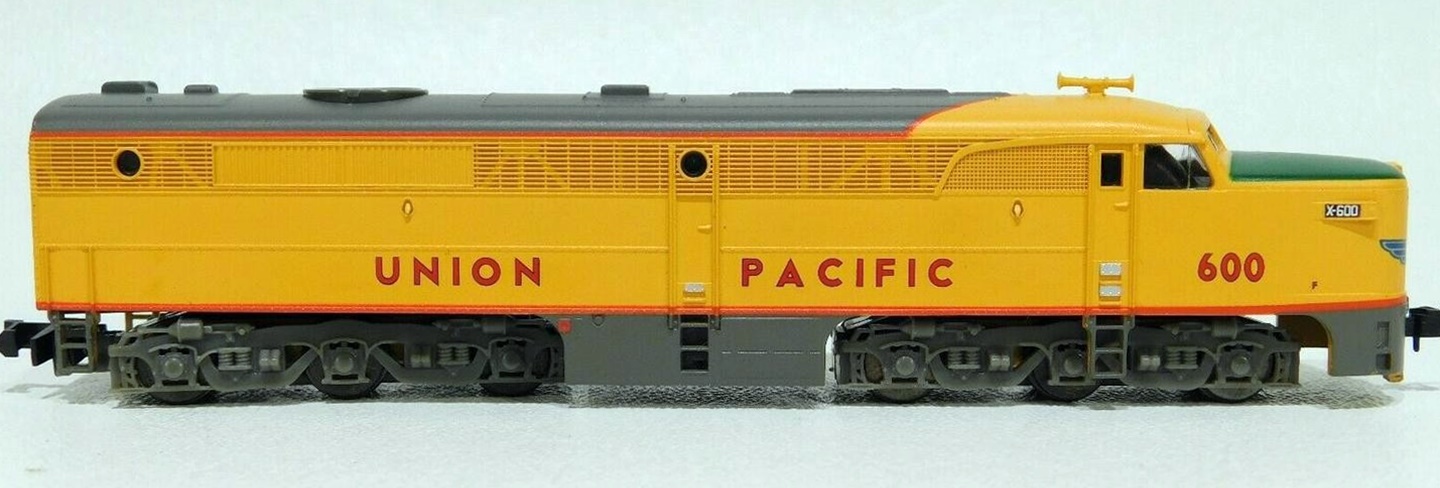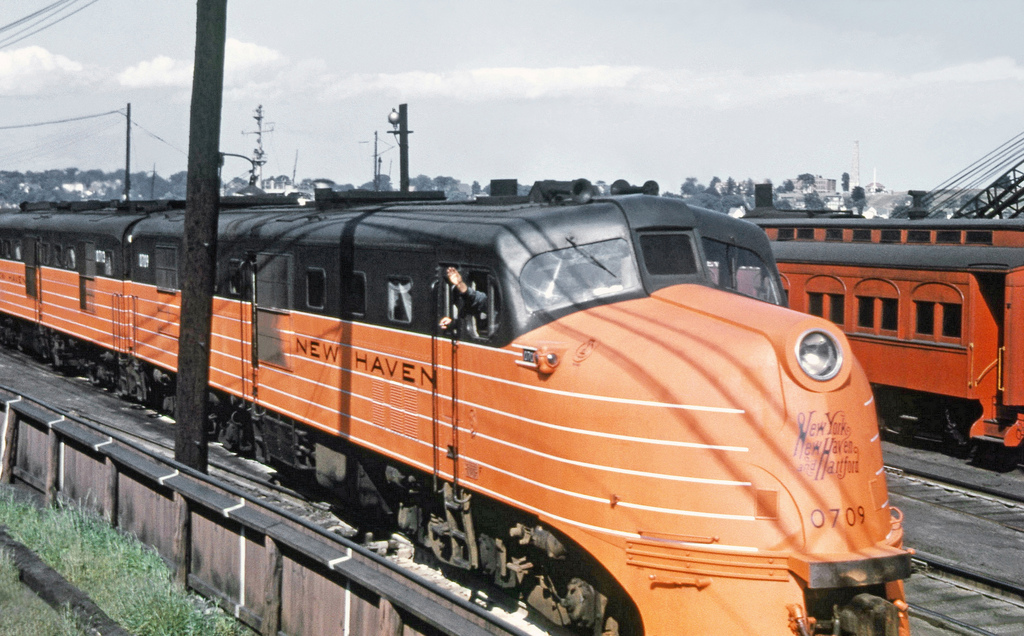Specific Item Information: Actually DL-107. Southern purchased two of these locomotives in 1941 together with their cabless B-units DL-108 (not available from Life-Like/Walthers).
Southern also purchased in 1942 a DL-109/DL-110 pair.
Southern also purchased in 1942 a DL-109/DL-110 pair.
Model Information: Life-Like first released in this model in 2005 as part of their 'Proto N' brand. Seven years later, Walthers followed up with a second release in 2012. The second release featured new road numbers for paint schemes from the 2005 release as well as entirely new paint schemes.
This N Scale model of the Alco DL-109 locomotive captures the slender lines of this 1940s prototype in a powerful, smooth-running N Scale model. Features include a heavy, split-frame chassis, five-pole motor with dual flywheels, eight-wheel drive, all-wheel electrical pickup and directional LED headlight. Between the finely detailed body (right down to the thin rivet strip around the cab windows) and authentic paint schemes, these units will look perfect on your passenger trains.
The coupler on the nose is an operating "dummy", while the rear coupler is a magnetic knuckle body-mounted coupler, AccuMate for the 2005 Life-Like Proto N release and Micro-Trains for the 2012 Walthers N release. As there are only negligible visual differences between DL-105, DL-107 and DL-109, Life-Like/Walthers produced only one model as DL-109 to stand in for all three types. The DL-109 was the by far the largest run of the series with a total of 62 built.
The coupler on the nose is an operating "dummy", while the rear coupler is a magnetic knuckle body-mounted coupler, AccuMate for the 2005 Life-Like Proto N release and Micro-Trains for the 2012 Walthers N release. As there are only negligible visual differences between DL-105, DL-107 and DL-109, Life-Like/Walthers produced only one model as DL-109 to stand in for all three types. The DL-109 was the by far the largest run of the series with a total of 62 built.
DCC Information: No provision for DCC in either release.
A DCC decoder installation for this model can be found on the thecentralstation.myfreeforum.org forum.
A DCC decoder installation for this model can be found on the thecentralstation.myfreeforum.org forum.
Prototype History: The ALCO DL-109 is one of six models of A1A-A1A Diesel locomotives built to haul passenger trains by the American Locomotive Company (ALCO) between December, 1939 and April, 1945 ("DL" stands for Diesel Locomotive). They were of a cab unit design, and both cab-equipped lead A units DL-103b, DL-105, DL-107, DL-109 and cabless booster B units DL-108, DL-110 models were built. The units were styled by noted industrial designer Otto Kuhler, who incorporated into his characteristic cab (US Patent D121,219) the trademark three-piece windshield design. A total of 74 cab units and four cabless booster units were built.
Alco's DL-109 marks their early entry into the passenger diesel market in 1940. With its sleek lines, knife-edged nose and long wheelbase, it was ideally suited for high-speed service, and with 2,000 horsepower under the hood, it could handle passengers or high-speed freight with ease. Because of its dual-service capabilities, Alco was allowed to construct the DL-109 in the face of wartime restrictions on passenger-only locos, and the units performed admirably round the clock, handling passengers during the day and freight trains at night. Using lessons learned with the DL-109, it was succeeded by the PA-1 in 1946. Full data sheet on The Diesel Workshop.
Read more on Wikipedia.
Alco's DL-109 marks their early entry into the passenger diesel market in 1940. With its sleek lines, knife-edged nose and long wheelbase, it was ideally suited for high-speed service, and with 2,000 horsepower under the hood, it could handle passengers or high-speed freight with ease. Because of its dual-service capabilities, Alco was allowed to construct the DL-109 in the face of wartime restrictions on passenger-only locos, and the units performed admirably round the clock, handling passengers during the day and freight trains at night. Using lessons learned with the DL-109, it was succeeded by the PA-1 in 1946. Full data sheet on The Diesel Workshop.
Read more on Wikipedia.
Road Name History:  The Southern Railway (reporting mark SOU) (also known as Southern Railway Company) was a US class 1 railroad that was based in the Southern United States. It was the product of nearly 150 predecessor lines that were combined, reorganized and recombined beginning in the 1830s, formally becoming the Southern Railway in 1894.
The Southern Railway (reporting mark SOU) (also known as Southern Railway Company) was a US class 1 railroad that was based in the Southern United States. It was the product of nearly 150 predecessor lines that were combined, reorganized and recombined beginning in the 1830s, formally becoming the Southern Railway in 1894.
At the end of 1970 Southern operated 6,026 miles (9,698 km) of railroad, not including its Class I subsidiaries AGS (528 miles or 850 km) CofG (1729 miles) S&A (167 miles) CNOTP (415 miles) GS&F (454 miles) and twelve Class II subsidiaries. That year Southern itself reported 26111 million net ton-miles of revenue freight and 110 million passenger-miles; AGS reported 3854 and 11, CofG 3595 and 17, S&A 140 and 0, CNO&TP 4906 and 0.3, and GS&F 1431 and 0.3
The railroad joined forces with the Norfolk and Western Railway (N&W) in 1982 to form the Norfolk Southern Corporation. The Norfolk Southern Corporation was created in response to the creation of the CSX Corporation (its rail system was later transformed to CSX Transportation in 1986). The Southern Railway was renamed Norfolk Southern Railway in 1990 and continued under that name ever since. Seven years later in 1997 the railroad absorbed the Norfolk and Western Railway, ending the Norfolk and Western's existence as an independent railroad.

At the end of 1970 Southern operated 6,026 miles (9,698 km) of railroad, not including its Class I subsidiaries AGS (528 miles or 850 km) CofG (1729 miles) S&A (167 miles) CNOTP (415 miles) GS&F (454 miles) and twelve Class II subsidiaries. That year Southern itself reported 26111 million net ton-miles of revenue freight and 110 million passenger-miles; AGS reported 3854 and 11, CofG 3595 and 17, S&A 140 and 0, CNO&TP 4906 and 0.3, and GS&F 1431 and 0.3
The railroad joined forces with the Norfolk and Western Railway (N&W) in 1982 to form the Norfolk Southern Corporation. The Norfolk Southern Corporation was created in response to the creation of the CSX Corporation (its rail system was later transformed to CSX Transportation in 1986). The Southern Railway was renamed Norfolk Southern Railway in 1990 and continued under that name ever since. Seven years later in 1997 the railroad absorbed the Norfolk and Western Railway, ending the Norfolk and Western's existence as an independent railroad.
Brand/Importer Information:  Life-Like Products LLC (now Life-Like Toy and Hobby division of Wm. K. Walthers) was a manufacturer of model railroad products and was based in Baltimore, Maryland.
Life-Like Products LLC (now Life-Like Toy and Hobby division of Wm. K. Walthers) was a manufacturer of model railroad products and was based in Baltimore, Maryland.
It was founded in the 1950s by a company that pioneered extruded foam ice chests under the Lifoam trademark. Because ice chests are a summer seasonal item, the company needed a way to keep the factory operating year round. As model railroading was becoming popular in the post-war years, they saw this as an opportunity and so manufactured extruded foam tunnels for model trains. Over the years, Life-Like expanded into other scenery items, finally manufacturing rolling stock beginning in the late 1960s. At some point in the early 1970s, Life-Like purchased Varney Inc. and began to produce the former Varney line as its own.
The Canadian distributor for Life-Like products, Canadian Hobbycraft, saw a missing segment in market for Canadian model prototypes, and started producing a few Canadian models that were later, with a few modifications, offered in the US market with US roadnames.
In 2005, the company, now known as Lifoam Industries, LLC, decided to concentrate on their core products of extruded foam and sold their model railroad operations to Wm. K. Walthers.
In June 2018, Atlas and Walthers announced to have reached an agreement under which all Walthers N scale rolling stock tooling, including the former Life-Like tooling, will be purchased by Atlas.
Read more on Wikipedia and The Train Collectors Association.

It was founded in the 1950s by a company that pioneered extruded foam ice chests under the Lifoam trademark. Because ice chests are a summer seasonal item, the company needed a way to keep the factory operating year round. As model railroading was becoming popular in the post-war years, they saw this as an opportunity and so manufactured extruded foam tunnels for model trains. Over the years, Life-Like expanded into other scenery items, finally manufacturing rolling stock beginning in the late 1960s. At some point in the early 1970s, Life-Like purchased Varney Inc. and began to produce the former Varney line as its own.
The Canadian distributor for Life-Like products, Canadian Hobbycraft, saw a missing segment in market for Canadian model prototypes, and started producing a few Canadian models that were later, with a few modifications, offered in the US market with US roadnames.
In 2005, the company, now known as Lifoam Industries, LLC, decided to concentrate on their core products of extruded foam and sold their model railroad operations to Wm. K. Walthers.
In June 2018, Atlas and Walthers announced to have reached an agreement under which all Walthers N scale rolling stock tooling, including the former Life-Like tooling, will be purchased by Atlas.
Read more on Wikipedia and The Train Collectors Association.
Item created by: Alain LM on 2016-08-08 02:56:04. Last edited by gdm on 2018-05-31 18:26:39
If you see errors or missing data in this entry, please feel free to log in and edit it. Anyone with a Gmail account can log in instantly.
If you see errors or missing data in this entry, please feel free to log in and edit it. Anyone with a Gmail account can log in instantly.









